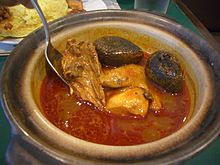- Peranakan cuisine
-
Peranakan or Nonya cuisine combines Chinese, Malay and other influences into a unique blend.
Peranakans are descendants of early Chinese migrants who settled in Penang, Malacca, Indonesia and Singapore, inter-marrying with local Malays. The old Malay word nonya (also spelled nyonya), a term of respect and affection for women of prominent social standing (part “madame” and part “auntie”), has come to refer to the cuisine of the Perakanans.
Nonya cooking is the result of blending Chinese ingredients and wok cooking techniques with spices used by the Malay/Indonesian community. The food is tangy, aromatic, spicy and herbal. Key ingredients include coconut milk, galangal (a subtle, mustard-scented rhizome similar to ginger), candlenuts as both a flavoring and thickening agent, laksa leaf, pandan leaves (Pandanus amaryllifolius), belachan, tamarind juice, lemongrass, torch ginger bud, jicama, fragrant kaffir lime leaf, rice or egg noodles and cincaluk - a powerfully flavored, sour and salty shrimp-based condiment that is typically mixed with lime juice, chillies and shallots and eaten with rice, fried fish and other side dishes.
There are regional variations in Nonya cooking. Dishes from the island of Penang in the northern part of Peninsular Malaysia show Thai influences, such as more liberal use of tamarind and other sour ingredients. Dishes from Singapore and Malacca show a greater Indonesian influence, such as the use of coconut milk. A classic example is laksa (a spicy noodle soup), which comes in two variants: the sour asam laksa from Penang and the coconut milk-based laksa lemak from Singapore and the southern regions of Peninsular Malaysia.
The unique flavor of laksa and other Nonya recipes is determined by the rempah, a combination of spices pounded into a paste with pestle and mortar, with a very specific texture and density. It is said that a nonya can determine the culinary skill of a new daughter-in-law simply by listening to her preparing rempah with a mortar. Nonya recipes are handed down from one generation to the next, and because of the time-consuming preparation of these dishes, it is a cuisine that is often at its best when served at home. Laksa is a notable exception to this rule.
Examples of Nonya specialities include otak-otak, a popular blend of fish, coconut milk, chilli paste, galangal, and herbs wrapped in a banana leaf;[1] Ayam Buah Keluak, a distinctive dish combining chicken pieces with nuts from the Pangium edule or kepayang tree to produce a rich sauce; and Itek Tim, a classic soup containing duck, tomatoes, green peppers, salted vegetables, and preserved sour plums simmered gently together.
Nonya desserts include colourful cakes (kuih) and sweet, sticky delicacies.
References
Categories:
Wikimedia Foundation. 2010.


